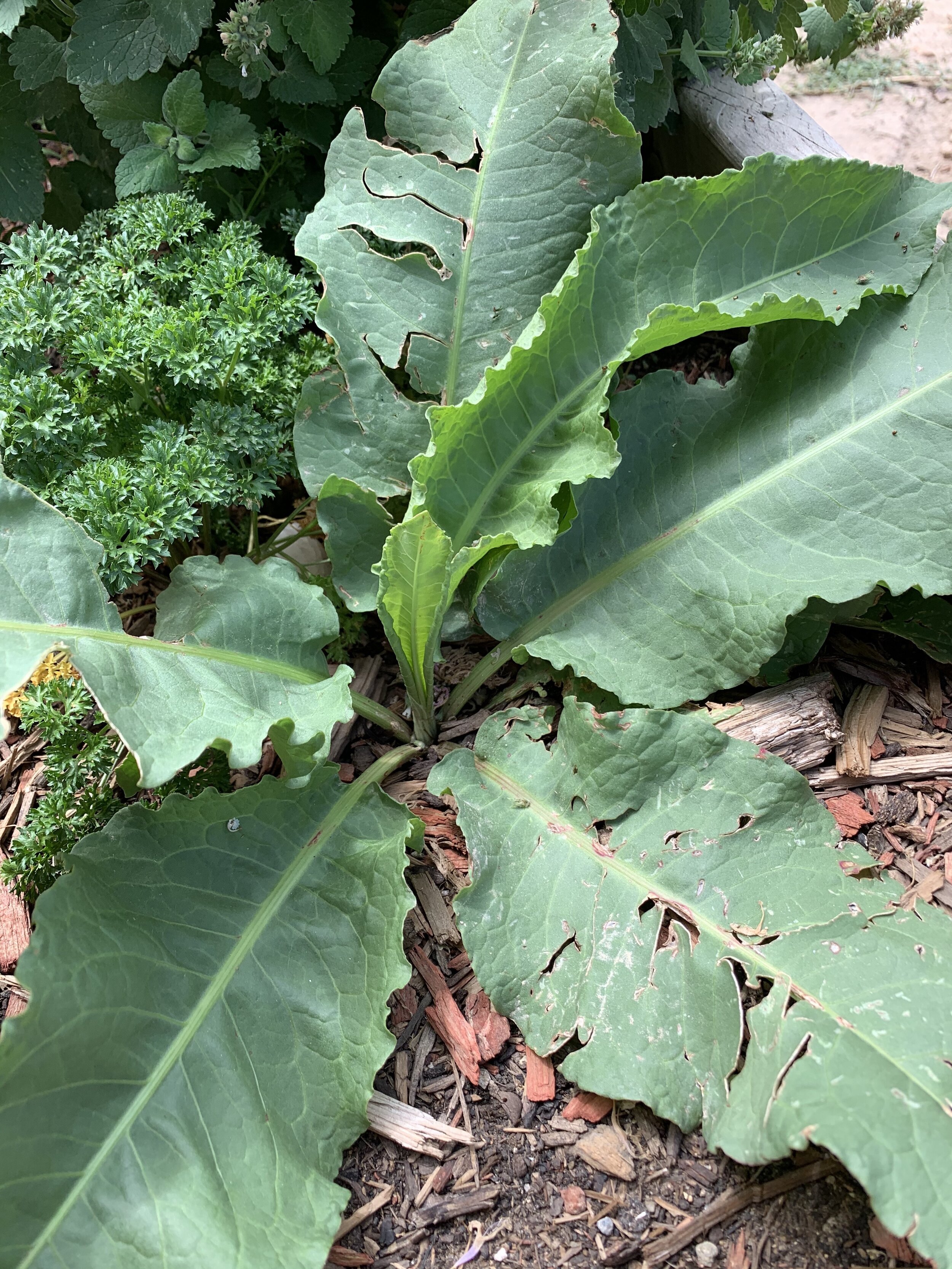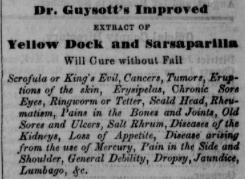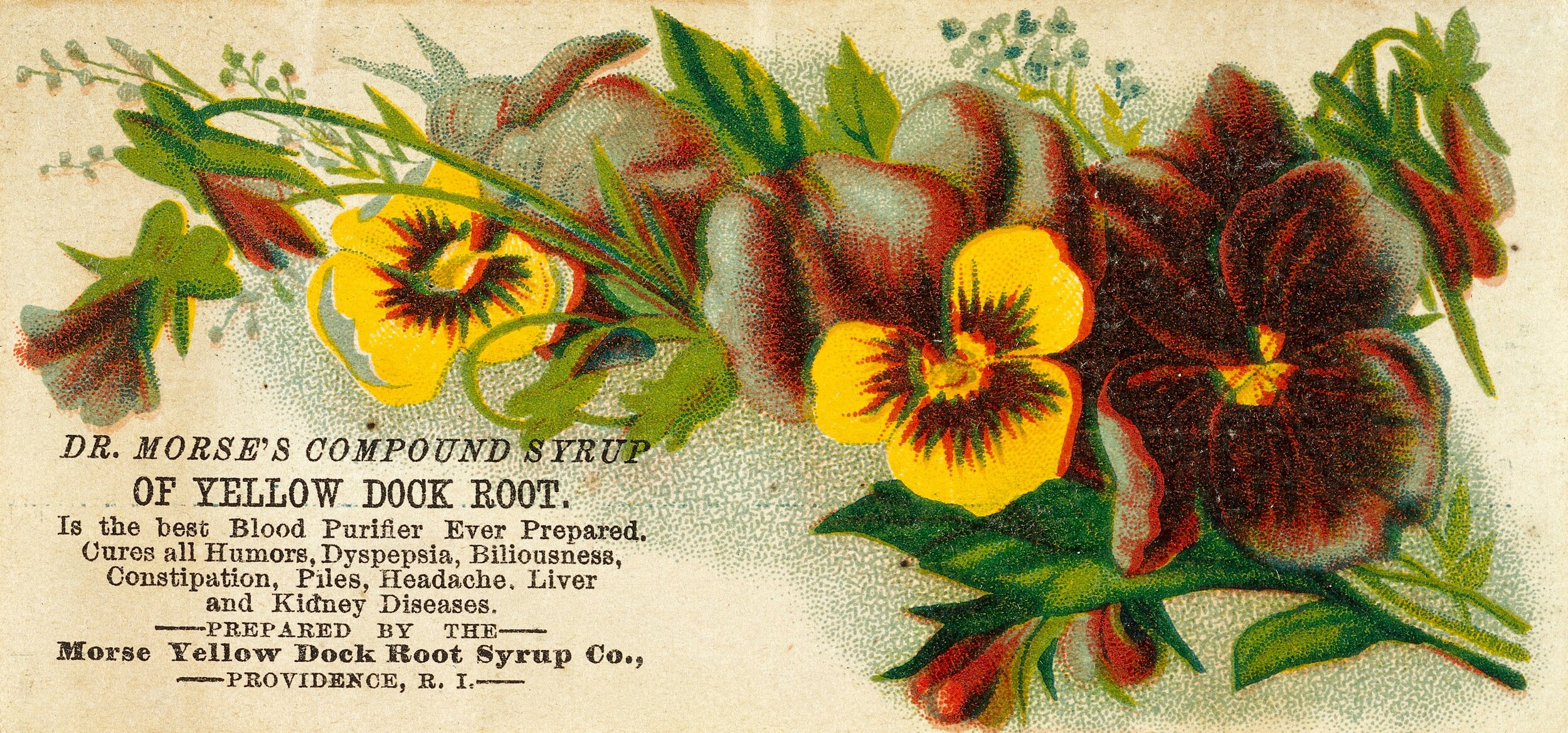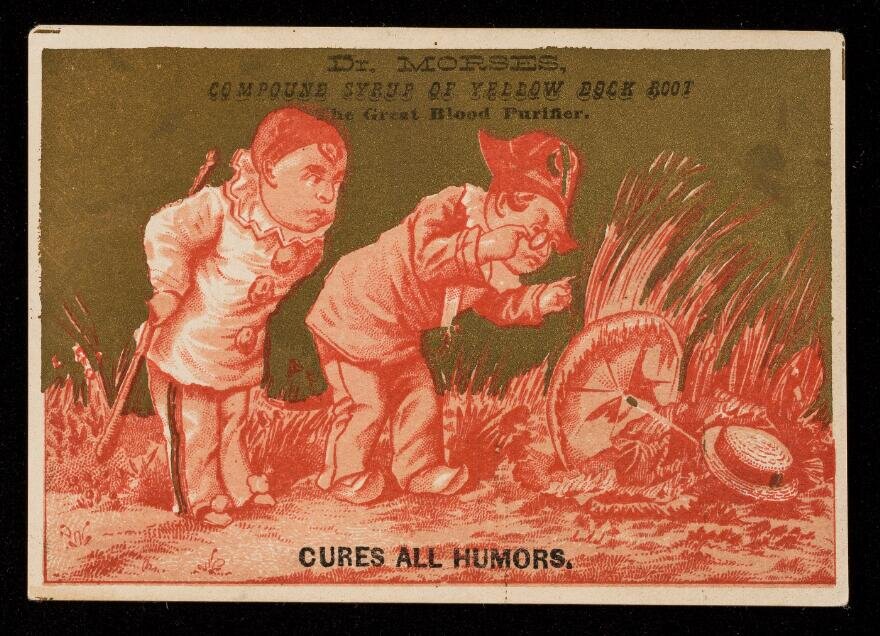Curly Dock: Would You Care to Try My Aphrodisiac Toothpaste?
Medicinally, Yellow Dock has seemingly been used for everything— by every culture—forever. Unfortunately, it was also heavy-peddled on the medicine show circuit alongside glass bottles of snake oil liniment and sarsaparilla tonic.
Traveler, while it is hard to tell which medicinal uses came from ancient linages and which came from the ‘patent medicine’ quack carts of the 1800’s, you will be surprised to learn the YELLOW DOCK is a plant of EXQUISITE VIRTUE.
***The Narrator dons his cumber bun and top hat***
Whether you are looking for a YELLOW DYE, salad green, APHRODISIAC, TOOTHPASTE, or a COFFEE SUBSTITUTE, this plant has its own EXTREME MERITS to tout.
So, STEP RIGHT UP!
***With baton, the Narrator raps thrice upon his stage coach***
Have a gander at this vegetative WONDER-PLANT. It is a MARVEL to BEHOLD and can ONLY BE FOUND growing, EXOTICALLY, along the side of every road on the PLANET EARTH!
*** The narrator sprouts an elegantly waxed mustache***
Welcome to the WILD and unexpectedly VERSATILE world of:
Rumex crispus
(CURLY DOCK)
Image taken Kevin Healey: pullupyourplants.com
Family — Polygonaceae
Family Characteristics —Flowers are small and have no petals, only 5-6 colored sepals. Seeds tend to be triangular to lens-shaped.
Aliases — bitter dock, bloodwort, canaigre, coffee weed, curly dock, lapathon, narrow dock, out-sting, pike plant, sour dock; Avelug (ARMENIAN) {meaining: unknown}; Gholo/ღოლო (GEORGIAN) {meaning: unknown}; σγουρή αποβάθρα {meaning: curly dock} (GREEK); Lengua De Vaca (SPANISH) {meaning: Cow’s Tongue}, Mala Hierba (SPANISH) {meaining:bad herb}; Dırşo (TURKISH) {meaning: unknown}.
Binomial Etymology — Rumex is a LATIN term meaning “sorrel,” and crisp, in LATIN, means “curled” [8].
Binomial Pronunciation: — ROO-mix KRISP-us
Description
Rumex crispus leaves are hairless oblong/lanceolate with wavy/undulating margins. A mature/second year plant can range from 1 -1.5 meters (2-5 feet) tall, and present leaves in an opposite arraignment with decreasing size on the way up the loosely branched flowering stems. The base of the plant and young leaves in this location will be enveloped in a slimy membrane (ocrea). The green flowers are not showy.
Image taken Kevin Healey: pullupyourplants.com
A seedling or first year plant will present as a basal rosette of elongated leaves with a starkly noticeable midrib and wavy margins as discussed above. Petioles will be of varying lengths.
Image taken Kevin Healey: pullupyourplants.com
A mature/flowering plant with green flowering stems and non-showy green flowers will give way to rusty red flowers and flowering stems during mid-to-late summer.
Image taken by the author.
The rust-colored achenes have papery three winged veinous membranes with a triangular shape from a cross-sectional prospective.
Habitat
Commonly seen on the sides of roads and in waste areas with good soil [9]. This is a common weed in agricultural fields.
Culinary Uses
Due to variable levels of oxalic acid (a compound found in spinach that makes it hard to absorb calcium and could encourage kidney stones), it is best to consume Rumex crispus, like everything, in moderation.
There have been reports of poisonings/allergic responses to this plant by some very credible people out there. If you know you have identified this plant correctly, proceed with caution to make sure you don’t manifest an allergic response.
See: UNIVERSAL EDIBILITY TEST.
Leaves
While the reported flavor of the young leaves, by many accounts, is said to be sour-to-bitter—requiring several changes of boiling water to become edible— I have found the young leaves of a third-year curly dock plant (late March) to be rather palatable and lacking in bold flavor. This is in agreement with the late H.D. Harrington’s empirical experiences [5].
“We consider the greens ‘bland’ tasting, and rather like them in mixtures with some others of a more pronounced taste…”
H.D. Harrington
I have found the young late-season (late July) leaves of a first-year curly dock to be pleasantly tart and lemon-flavored fresh. The older leaves, boiled in two changes of water, had a squishy/mushy texture with a far-off and unidentifiable “mammalian musk” flavor that I found disagreeable. I’d avoid the old leaves unless you are starving.
The CHINCHERO natives of SOUTHERN PERU use the young leaves both fresh in salad and cooked [6].
People of GEORGIA use the leaves to prepare Phkhali [15].
Seeds
Image taken Kevin Healey: pullupyourplants.com
The seeds were roasted and used as a coffee substitute [10] especially among southern Confederates during the American Civil War[11].
“Tea and coffee practically disappeared, but it was found that the coffee weed supplied a passable substitute...”
Many contemporary web-based sources repeat that curly dock seeds can be used as a coffee substitute, but I actually gave it a shot in the video below. It tastes passable, nutty, and — while not an exact replica of coffee— a tasty beverage in its own right.
Ethnobotany of Curly Dock
Residents of Indiana, USA, (aka HOOSIERS), used Curly Dock as a tooth-powder/toothpaste, aphrodisiac, ringworm treatment, topical cancer treatment, and blood thinner [2]. For all of you intrepid capitalists out there, I’ve got two words: Aphrodisiac Toothpaste. Good luck.
The AYURVEDA— a 5,000-year old Sanskrit medical text that transcribed from even more ancient oral traditions emerging from the INDIAN subcontinent— mentions curly dock as a “cool and dispersing herb” that was useful in treating diarrhea, glandular tumors, and viruses [3].
The people of Wexford, IRELAND, have been recorded using the juices of the plants soaked into a cloth to treat “stone bruises,” and a root decoction as a strong laxative [4].
The PIMA used the root to produce a yellow dye [7].
The BLACKFOOT used the root pulp for swellings and sores; the CHEROKEE utilized an infusion of the plant for dysentery, an infusion of the root as a blood medicine, for skin problems, as a kidney medicine, laxative, and rubbed the leaves in their mouths to treat sore throat; the CHEYENNE used an infusion of the dried root for lung hemorrhages, a root poultice for wounds; the CHIPPEWA used the dry/pounded root for wounds and itching [17].
The roots were used by the PAPAGO and HOPI to help with the common cold.
ANCIENT ROMANS, spoken for by one of our favorite dudes of all time, PLINY the ELDER, used wild dock (which they called wild lapathum) used the plant to treat scorpion stings, the seeds for stomach troubles, the root for a mouthwash, and cure for jaundice.
Curanderos of NORTHERN PERU utilize Rumex crispus to treat vaginal inflammation, uterine infection, and kidney inflammation [12].
The people of TURKEY utilize the Curly Dock to treat leg pain, and tubercles, and constipation [13].
In PAKISTAN, Curly Dock is used as an antimicrobial, antioxidant, anti-inflammatory, and as a cure for edema; the roots are used to treat intestinal distress [14][16].
Pliny the Elder from a 1635 CE printing of Historia Naturalis.
“The wild varieties of the lapathum are a cure for the stings of scorpions, and protect those who carry the plant on their person from being stung. A decoction of the root in vinegar, employed as a gargle, is beneficial to the teeth, and if drunk, is a cure for jaundice. The seed is curative of the most obstinate maladies of the stomach.”
Tasting Pliny the Elder’s Yellow Dock Mouthwash
Curly Dock Aphrodesiac Toothpaste
Curly Dock in Artwork
Study of Water and Plants by Thomas Fearnley (Norwegian, Frederikshald 1802–1842 Munich) 1837. This image is in the Public Domain, and was retrieved from The Met website (LINK).
Yellow Dock: The Medicine Show Gallery
‘Yeller Dock’ in Literature
“Jest wanted to know. I guess you're
old enough to be a gran'pap. Balder'n I
be. Ever try yaller dock tea to keep your
hair from comin’ out? It worked well with
me, but it never done my oldest boy no good.
He's balder'n I be an him not thutty.”
Merryman, Max.(1881). The judge. New York, N.Y.: [Judge Publishing Company].
“I can’t do nothin’ with Olive, anyway. She won’t have a doctor. I told her she wanted tonin’ up. She needs bitters, but she won’t take a thing. She don’t eat nor sleep. l’ve steeped thoroughwort ‘n’ yeller-dock, but she won’t have nothin’ to do with it. Iarst her what kind of a quarrel you ‘n’ she had had, ‘n’ she jest looked at me ‘n’ wouldn’t speak. She ain’t a grain like herself.”
“...something boiled over on the kitchen stove, and she sprang up exclaiming that it was the yeller- dock, and that she knew that kittle wouldn’t hold so much; but it had got to be three quarts boiled down to one quart, and that was the only kittle they had. Judith stepped quickly forward and swung off the vessel, placing it in the sink, while a strong, bitter smell pervaded the room. Mrs. Grover began to mop up that portion of the liquid that had run over on to the floor.”
“Why can’t ye yell to Elziry Spinney to tell her boy to pull some that yeller - dock root out back their house?” replied Ephraim . “I kinder hanker after it.... I sh’ think you could; might be my dying wish, for all you know. I can feel my liver palpitating ‘bout twice too fast .”
“Through the stillness the crack of Seth’s long whip resounded clear and sharp. The mules broke sullenly into a heavy trot. The smell of a rank vegetation filled their nostrils. Tall, coarse coffee-weeds smote them mercilessly with damp, ghostly fingers.”
“What better excuse for a Sunday afternoon hike is there than saying, “I have to see if the Curly Dock is up.””
“Tiny butterflies like bits of black velvet fluttered about the golden-rod, the yellow coffee-weed, and the tall, feathery grasses like burnished copper which covered the bayou’s bank.”























